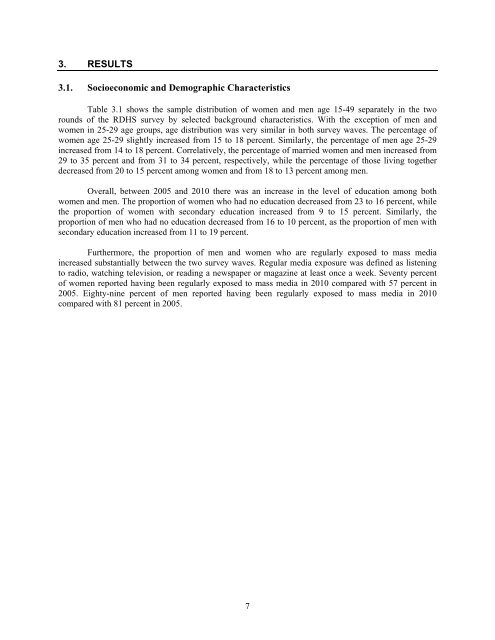Recent Trends in HIV-Related Knowledge and ... - Measure DHS
Recent Trends in HIV-Related Knowledge and ... - Measure DHS
Recent Trends in HIV-Related Knowledge and ... - Measure DHS
Create successful ePaper yourself
Turn your PDF publications into a flip-book with our unique Google optimized e-Paper software.
3. RESULTS3.1. Socioeconomic <strong>and</strong> Demographic CharacteristicsTable 3.1 shows the sample distribution of women <strong>and</strong> men age 15-49 separately <strong>in</strong> the tworounds of the R<strong>DHS</strong> survey by selected background characteristics. With the exception of men <strong>and</strong>women <strong>in</strong> 25-29 age groups, age distribution was very similar <strong>in</strong> both survey waves. The percentage ofwomen age 25-29 slightly <strong>in</strong>creased from 15 to 18 percent. Similarly, the percentage of men age 25-29<strong>in</strong>creased from 14 to 18 percent. Correlatively, the percentage of married women <strong>and</strong> men <strong>in</strong>creased from29 to 35 percent <strong>and</strong> from 31 to 34 percent, respectively, while the percentage of those liv<strong>in</strong>g togetherdecreased from 20 to 15 percent among women <strong>and</strong> from 18 to 13 percent among men.Overall, between 2005 <strong>and</strong> 2010 there was an <strong>in</strong>crease <strong>in</strong> the level of education among bothwomen <strong>and</strong> men. The proportion of women who had no education decreased from 23 to 16 percent, whilethe proportion of women with secondary education <strong>in</strong>creased from 9 to 15 percent. Similarly, theproportion of men who had no education decreased from 16 to 10 percent, as the proportion of men withsecondary education <strong>in</strong>creased from 11 to 19 percent.Furthermore, the proportion of men <strong>and</strong> women who are regularly exposed to mass media<strong>in</strong>creased substantially between the two survey waves. Regular media exposure was def<strong>in</strong>ed as listen<strong>in</strong>gto radio, watch<strong>in</strong>g television, or read<strong>in</strong>g a newspaper or magaz<strong>in</strong>e at least once a week. Seventy percentof women reported hav<strong>in</strong>g been regularly exposed to mass media <strong>in</strong> 2010 compared with 57 percent <strong>in</strong>2005. Eighty-n<strong>in</strong>e percent of men reported hav<strong>in</strong>g been regularly exposed to mass media <strong>in</strong> 2010compared with 81 percent <strong>in</strong> 2005.7







![Obtaining Informed Consent for HIV Testing [QRS4] - Measure DHS](https://img.yumpu.com/49850117/1/190x245/obtaining-informed-consent-for-hiv-testing-qrs4-measure-dhs.jpg?quality=85)








